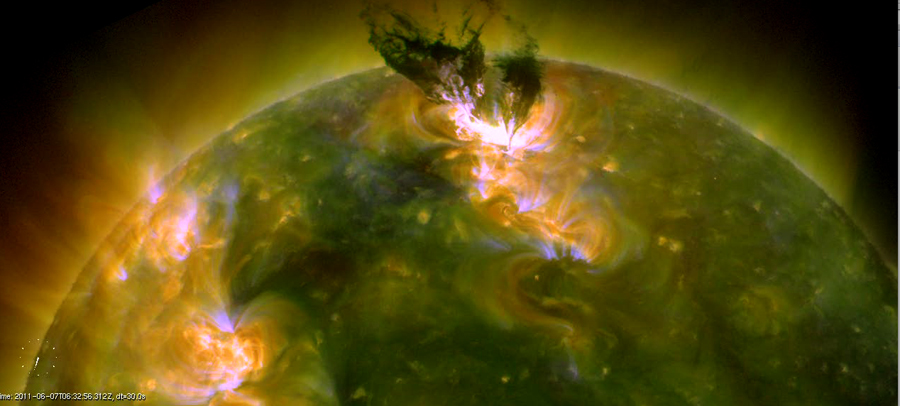Gargantuan Sun Explosion Rocks Astronomers

A huge storm on the sun this week unleashed what some have called the most massive eruption of solar plasma ever seen. While that's up for review, the solar storm has revealed a tantalizing glimpse at the inner workings of our nearest star, scientists say.
NASA astronomers said the huge June 7 solar eruption, called a coronal mass ejection, probably wasn't the biggest ever, but it is notable both for its size and its perplexing behavior. Huge waves of plasma roared off the sun only to rain back down on the solar surface.
"We're seeing things we've never seen before," said Phillip Chamberlin, an astrophysicist at NASA's Goddard Spaceflight Center in Greenbelt, Md., and a deputy project scientist on the agency's Solar Dynamics Observatory (SDO) satellite. "It's a really exciting event. There are a lot of exceptions to it." [Big Blast on Sun Seen in 4-Scope View ]
The solar storm occurred on Tuesday (June 7), and lasted about three hours. It produced a sudden brightening of the sun called a solar flare that was only a moderate, or Class M, event. However, it also let loose the coronal mass ejection, which is a cloud of charged particles that erupted into space from the surface of the sun.

Sun shower of plasma rain
Usually, coronal mass ejection material flies off into space, sometimes hurling toward Earth. But this time, a large majority of it fell back down to the solar surface. [Amazing New Sun Photos from Space]
"The particles that were shot off expanded to a very large volume, sort of a mushroom cloud, and then a lot fell back down to the sun," Chamberlin said.
Get the Space.com Newsletter
Breaking space news, the latest updates on rocket launches, skywatching events and more!
However, enough material was sent Earthward that skywatchers are expecting some extra-bright displays of the Northern Lights, or auroras, this week.
Why it happened this way, instead of the usual process of ejecting out into space, is still a mystery.
"We're still trying to figure that one out," Chamberlin told SPACE.com. "That's science. I don't know. We're stumped."
Sun secrets revealed?
But the scientists are eagerly studying the event to attempt to understand the event. They are aided by video footage of the event from SDO, as well as NASA's twin Stereo spacecraft orbiting the sun from points ahead of and behind Earth, providing multiple angles on the solar activity.
"We should get a good stereoscopic view and try to model this and understand what's going on, why is there so much plasma raining down," Chamberlin said.
Another mystery researchers are hoping to solve is why this super-powerful coronal mass ejection was paired with just a moderate solar flare. Experts aren't sure about the connection between the two events, which usually seem to roughly correlate both in timing and strength.
"One of the big questions in solar science is the relationship between solar flares and coronal mass ejections," Chamberlin said. "Can you have one without the other or are they really intimately tied? There are people in the field that will argue both ways."
Watershed sun storm
Having such a unique event to investigate is sure to provide some new insights into the riddle, Chamberlin said.
In fact, he estimated that tens to hundreds of research papers would likely come out of just this one event, and a number of graduate students will likely do their entire Ph.D. research on this particular solar storm.
"The scientists are really excited, to the point where it's kind of like a watercooler," Chamberlin said. "Everybody here at Goddard is all talking with each other. We have a video wall and we're just standing around looking at it, picking out new things."
And it truly is a good time to be a solar scientist, because this event is just the beginning. The sun is waking up from a slump in its normal 11-year cycle of activity. A period of solar minimum, with few storms or flares, occurred a few years ago, and the sun is expected to reach maximum activity at the end of 2013.
"We're going to get a lot more of these events coming up in the next couple years, probably bigger events as well," Chamberlin said.
You can follow SPACE.com Senior Writer Clara Moskowitz on Twitter @ClaraMoskowitz. Follow SPACE.com for the latest in space science and exploration news on Twitter @Spacedotcom and on Facebook.
Join our Space Forums to keep talking space on the latest missions, night sky and more! And if you have a news tip, correction or comment, let us know at: community@space.com.

Clara Moskowitz is a science and space writer who joined the Space.com team in 2008 and served as Assistant Managing Editor from 2011 to 2013. Clara has a bachelor's degree in astronomy and physics from Wesleyan University, and a graduate certificate in science writing from the University of California, Santa Cruz. She covers everything from astronomy to human spaceflight and once aced a NASTAR suborbital spaceflight training program for space missions. Clara is currently Associate Editor of Scientific American. To see her latest project is, follow Clara on Twitter.









